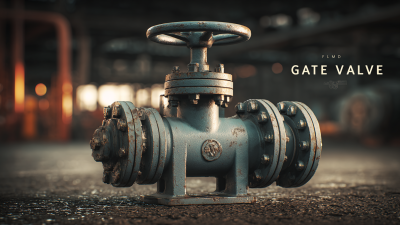

- 713.590.1312
- sale@pandbtools.com
Understanding the Benefits of Using Flanged Gate Valves in Industrial Applications
In the realm of industrial applications, the selection of appropriate valve types is crucial for optimizing performance and ensuring safety. Among the various options available, the Flanged Gate Valve stands out due to its robust construction and reliable operation in high-pressure environments.
According to a report by MarketsandMarkets, the global valve market is expected to reach USD 99.6 billion by 2025, with gate valves, including flanged variants, comprising a significant share due to their favorable characteristics for fluid control. Flanged Gate Valves are particularly valued for their ability to provide a tight seal and minimal flow resistance when fully opened, making them ideal for flow regulation in applications such as oil and gas, water management, and chemical processing.
By understanding the operational benefits and strategic implementation of Flanged Gate Valves, industries can enhance efficiency and reliability in their systems.

How to Choose the Right Flanged Gate Valve for Your Industrial Needs
When selecting a flanged gate valve for your industrial applications, it is essential to consider several key factors to ensure optimal performance and reliability.
First, assess the specifications of your system, including temperature and pressure requirements. Different materials offer various benefits; for example, stainless steel provides
excellent corrosion resistance, while ductile iron can withstand high pressures.
Tips: Always check the valve's pressure rating against your system’s maximum pressure to prevent failures.
It’s also vital to consider the valve’s size and flow characteristics, ensuring that it aligns with the existing piping layout and meets the application's flow demands.
Another important consideration is the valve's sealing mechanism. A well-designed flanged gate valve will have robust seals to prevent leaks and ensure longevity.
Evaluate the valve's maintenance requirements, as some designs require more frequent servicing than others, impacting downtime in your operations.
Tips: Look for valves with replaceable seals or those that allow for easy maintenance, helping to minimize downtime and repair costs.
How to Properly Install Flanged Gate Valves for Optimal Performance
Proper installation of flanged gate valves is crucial for ensuring their optimal performance in industrial applications. The first step in the installation process involves selecting the appropriate valve type that matches the specifications of the piping system. It’s essential to inspect the valve for any signs of damage and verify that it is compatible with the media being regulated. Before installation, ensure that the flanges are clean and free from debris, as any contamination can compromise the seal and performance of the valve.
During installation, one should align the valve properly with the piping to prevent undue stress on the valve body. Use appropriate gaskets and tighten the flange bolts in a crisscross pattern to ensure uniform pressure distribution, which helps in achieving a leak-proof seal. It is important to adhere to the manufacturer's torque specifications to avoid over-tightening, which can lead to flange deformation. Once installed, conduct a pressure test to confirm the integrity of the installation before putting the system into operation. Following these guidelines will help in maximizing the efficiency and lifespan of flanged gate valves in any industrial setting.
How to Maintain Flanged Gate Valves to Ensure Longevity and Reliability
Maintaining flanged gate valves is essential for ensuring their longevity and reliable performance in industrial applications. Regular inspection is a critical first step; operators should check for any visible signs of wear, corrosion, or damage to the valve body and sealing surfaces. Particular attention should be given to the seating surfaces, as any imperfections can lead to leaks and reduced efficiency. Proper lubrication of the valve stem and other moving parts is also necessary to prevent wear and tear and ensure smooth operation.
Another key maintenance practice involves monitoring operating conditions. Flanged gate valves should be operated within their specified pressure and temperature ranges to avoid undue stress that can lead to premature failure. Additionally, it is advisable to periodically disassemble the valves for a thorough cleaning and to replace any worn components. Keeping a detailed maintenance log can help track performance over time, allowing for proactive measures to be taken before significant issues arise. By adhering to these maintenance guidelines, facilities can prolong the lifespan of their flanged gate valves and minimize operational disruptions.
How to Troubleshoot Common Issues with Flanged Gate Valves in Operations
Flanged gate valves are widely used in industrial applications due to their ability to provide a tight seal and facilitate smooth flow under high pressures. However, like any mechanical component, they can experience issues over time. One common problem is the accumulation of debris and sediment, which can interfere with the valve's operation. To troubleshoot this, it is essential to inspect the valve for any signs of blockage, and ensure regular maintenance is conducted to clean the valve internally.
Another frequent issue is valve leakage, which often occurs due to wear and tear on the seals or improper installation. To address leaks, operators should first verify the flange connections to ensure they are properly tightened. If leaks persist, replacing the seals may be necessary. Additionally, it is important to check for any misalignment in the piping that could exacerbate the problem. By performing these troubleshooting steps, operators can ensure that flanged gate valves remain efficient and reliable in their industrial settings.
How to Compare Flanged Gate Valves to Other Valve Types for Your Applications
When considering flanged gate valves for industrial applications, it's essential to compare them with other valve types to identify the most suitable option for your needs. Flanged gate valves are known for their durability and ability to provide a tight seal, making them ideal for applications involving liquids and gases under high pressure. In contrast, other valve types, such as ball or butterfly valves, may excel in scenarios requiring quick operation or precise flow control.
When conducting your comparison, consider the specific requirements of your application, such as pressure, temperature, and flow characteristics. Flanged gate valves generally offer a straight-through flow path, minimizing resistance and turbulence, which is crucial for maintaining system efficiency. On the other hand, valves like globe valves can offer better throttling capabilities.
**Tips:** Always check the material compatibility with the media being transported as well as the size and pressure ratings before making your selection. Additionally, assess the maintenance requirements, as flanged gate valves may need more frequent servicing in harsh environments. Make sure to consult technical specifications and seek advice from industry experts when necessary to ensure optimal performance and longevity of your valve choice.
Benefits of Flanged Gate Valves Compared to Other Valve Types
This bar chart compares the performance indicators of flanged gate valves with other common valve types used in industrial applications. Flanged gate valves score the highest due to their effective sealing capabilities and suitability for high-pressure applications, making them a preferred choice in numerous industries.
Related Posts
-

What is a Flanged Gate Valve and Why It’s the Best Choice for Your Industrial Needs?
-

Top 10 Globe Control Valve Manufacturers from China at the 137th Canton Fair
-

Mastering Flow Valves in Industrial Applications A Comprehensive Tutorial for Beginners
-

Forecasting the Market Landscape: The Rise of Best Check Valves by 2025
-

5 Reasons Why Best Bellow Seal Valve Outperforms Competitors in Industry Standards
-

Comparative Analysis of the Top 5 Best Swing Check Valves: Efficiency and Performance Metrics Revealed

